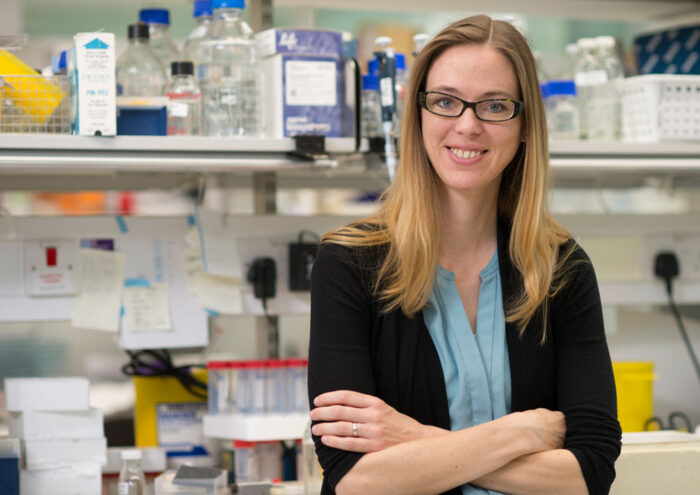
Madeline Lancaster, a group leader in the LMB’s Cell Biology Division, has been awarded the International Society for Stem Cell Research (ISSCR) Dr Susan Lim Award for Outstanding Young Investigator for 2021. The award recognises the exceptional achievements of an investigator in the early part of their independent career in stem cell research and is supported by the Dr Susan Lim Endowment for Education and Research Ltd. Formed in 2002, the ISSCR promotes global collaboration among the world’s most talented and committed stem cell scientists and physicians, and plays a catalysing role in the development of effective new medical treatments.
Madeline’s research is focused on studying brain development and disease using in vitro methods. She developed and pioneered the use of a 3D model of the embryonic human brain created from stem cells. In this model, brain tissue is able to spontaneously self-organise to form a structure resembling the brain, known as a cerebral organoid. This was a major scientific breakthrough that allowed, for the first time, the complexity and structure of the developing brain to be replicated in vitro.
Madeline’s group have continued to develop this model, incorporating aspects of bioengineering to improve their reproducibility. Further work has demonstrated their ability to mature and form complex networks with highly interconnected neurons and long-range projections. Such advanced cultures were shown to form functional connections to spinal cord tissue placed nearby, and to trigger muscle contractions of attached muscle. Brain organoids are beginning to provide insight into various diseases, for example, human microcephaly, where organoids created from patient-derived induced pluripotent stem cells are abnormally small, consistent with the smaller brains seen in microcephaly patients.
More recently, Madeline’s group have shown another application for their work in investigating whether SARS-CoV-2, the virus responsible for COVID-19, is able to infect cells in our brain. They developed a brain organoid model of the choroid plexus (ChP), which produces and secretes cerebrospinal fluid (CSF) and forms a barrier between the CSF that bathes the brain and the blood. They found that ChP cells express ACE2, the receptor needed for SARS-CoV-2 entry, on their surface and that the virus was able to infect and produce new virus inside ChP epithelial cells. The damage it causes at the brain barrier may lead to cytokine and immune cell invasion and result in long-term neurological symptoms such as chronic fatigue.
The development of cerebral organoids has significant implications not only for studying neurological diseases and the development of new treatments, but also, in the future, the brain organoid method could be developed to model psychiatric disorders and even the ageing brain and neurodegeneration.
Madeline will be honoured at the virtual ISSCR Annual Meeting, and give a presentation during a plenary session, in June 2021.
Madeline commented: “It is such an honour to be chosen for this prestigious award. It is a testament to all the hard work of my lab members, who have been a fantastic group to work with. I could not have done it without them!”
Further references:
Madeline’s group page
Madeline Lancaster: The accidental organoid – mini-brains as models for human-brain development
ISSCR Awards